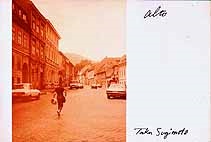After 1994’s Slub: Unaccompanied Violoncello Solo, Taku Sugimoto stopped playing the cello, to which he’d devoted the past few years, and returned to the electric guitar. The resulting 20-minute 3″ CD, again released on Sugimoto’s own Slub Music label, was a turning point for the young musician, the first hint of the approach he’d refine on the series of solo guitar records he’d release in the subsequent few years. Where the lengthy Slub, with its dense, squeaky cello assaults, was an ear- and patience-trying listen, Alto is compact, airy, and spacious, the work of a musician starting to discover that he needn’t carpet every available space with noise in order to be heard.
It’s also, in its brief length, far more varied than the monolithic Slub. Sugimoto is obviously trying out a catalogue of approaches here, exploring different textures and to some degree dedicating each of the tracks to a single technique or type of sound. On the first track, single guitar tones resonate in a hissy void. There’s space, but at only three minutes long, never that much space, and there’s a multitude of little clicks and semi-accidental string brushing in the silences between each tone. Sugimoto varies his attack, sometimes sharply plucking out a strangled note, other times holding a warmer tone for a few moments as it naturally fades back into the quiet.
Sugimoto initially continues in the same restrained vein on the longer second piece, but gradually starts building a twangy, circular groove that serves as a center point for ambling digressions. It’s almost bluesy but Sugimoto keeps letting the pulse collapse, attacking its steady momentum with shards of rapid Derek Baileyesque abstractions, inserting little squiggles and asides at every opportunity but returning to the bluesy chords just often enough that the underlying sensibility just barely manages to carry through it all.
The third piece finds Sugimoto experimenting with the zither instead, gently rubbing the strings to create delicate low-volume textures, juxtaposed with sharp wooden rapping noises and occasional metallic interjections. It’s somewhat aimless in comparison to the guitar tracks, but still provides an early indication of where Sugimoto’s musical interests were heading. On the fourth piece, feedback is shaped into a piercing electronic wave, with only the occasional slight, almost incidental string noise at the edges of the pure drone providing a reminder of the guitar’s presence. It’s not a sound Sugimoto would return to much in the coming years, but here it seems like one more tool he’s trying out, another sound-making possibility briefly auditioned.
Around the same time as the recording of this EP, Sugimoto was playing a lot with his friend and fellow guitarist Tetuzi Akiyama, forming the duo Akiyama-Sugimoto and recording a handful of tapes. The duo also showed up on the Gentle Giant compilation The Miracle of Levitation, joined by drummer Atsuko Ohno for a rather straightforward psych-blues jam that seems to point back to Sugimoto’s earlier music rather than what he was working on in his solo work. Akiyama, though, would become an important collaborator with Sugimoto into the early 2000s, and he shows up as a second guitarist on the very brief final track on Alto, which is appropriately drenched in distortion and noise, with both guitarists creating squalls of noise and chunky rhythms formed from static.
Alto‘s variety and brevity make it seem like a sampler of Sugimoto’s musical thinking at the cusp of his real creative breakthroughs. None of these tracks delve very deeply into the ideas he’s exploring, but what’s apparent already is that Sugimoto is jettisoning past approaches and thinking seriously about how he’s going to make music from here on. This of course would be a continuing thread throughout his work. A restless musician, Sugimoto has seldom been content to settle into a single mode of playing or creating long-term. His trajectory has included several sudden reversals and reinventions, of which the transformation displayed here from rock maximalist to thoughtful experimental minimalist would be only the first.
